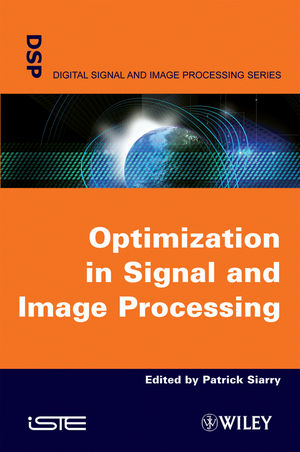Optimisation in Signal and Image ProcessingISBN: 978-1-84821-044-8
Hardcover
352 pages
October 2009, Wiley-ISTE
 |
||||||
Chapter 1. Modeling and Optimization in Image Analysis
1
Jean Louchet
1.1. Modeling at the source of image analysis and synthesis 1
1.2. From image synthesis to analysis 2
1.3. Scene geometric modeling and image synthesis 3
1.4. Direct model inversion and the Hough transform 4
1.5. Optimization and physical modeling 9
1.6. Conclusion 12
1.7. Acknowledgements 13
1.8. Bibliography 13
Chapter 2. Artificial Evolution and the Parisian Approach.
Applications in the Processing of Signals and Images 15
Pierre Collet and Jean Louchet
2.1. Introduction 15
2.2. The Parisian approach for evolutionary algorithms 15
2.3. Applying the Parisian approach to inverse IFS problems 17
2.4. Results obtained on the inverse problems of IFS 20
2.5. Conclusion on the usage of the Parisian approach for inverse IFS problems 22
2.6. Collective representation: the Parisian approach and the Fly algorithm 23
2.7. Conclusion 40
2.8. Acknowledgements 41
2.9.Bibliography 41
Chapter 3. Wavelets and Fractals for Signal and Image
Analysis 45
Abdeldjalil Ouahabi and Djedjiga Ait Aouit
3.1. Introduction 45
3.2. Some general points on fractals 46
3.3. Multifractal analysis of signals 54
3.4. Distribution of singularities based on wavelets 60
3.5. Experiments 70
3.6. Conclusion 76
3.7. Bibliography 76
Chapter 4. Information Criteria: Examples of Applications in
Signal and Image Processing 79
Christian Oliver and Olivier Alata
4.1. Introduction and context 79
4.2. Overview of the different criteria 81
4.3. The case of auto-regressive (AR) models 83
4.4. Applying the process to unsupervised clustering 95
4.5. Law approximation with the help of histograms 98
4.6. Other applications 103
4.7. Conclusion 106
4.8. Appendix 106
4.9. Bibliography 107
Chapter 5. Quadratic Programming and Machine Learning –
Large Scale Problems and Sparsity 111
Gaëlle Looslil, Stéphane Canu
5.1. Introduction 111
5.2. Learning processes and optimization 112
5.3. From learning methods to quadratic programming 117
5.4. Methods and resolution 119
5.5. Experiments 128
5.6. Conclusion 132
5.7. Bibliography 133
Chapter 6. Probabilistic Modeling of Policies and Application
to Optimal Sensor Management 137
Frédéric Dambreville, Francis Celeste and Cécile
Simonin
6.1. Continuum, a path toward oblivion 137
6.2. The cross-entropy (CE) method 138
6.3. Examples of implementation of CE for surveillance 146
6.4. Example of implementation of CE for exploration 153
6.5. Optimal control under partial observation 158
6.6. Conclusion 166
6.7. Bibliography 166
Chapter 7. Optimizing Emissions for Tracking and Pursuit of
Mobile Targets 169
Jean-Pierre Le Cadre
7.1. Introduction 169
7.2. Elementary modeling of the problem (deterministic case) 170
7.3. Application to the optimization of emissions (deterministic case) 175
7.4. The case of a target with a Markov trajectory 181
7.5. Conclusion 189
7.6. Appendix: monotonous functional matrices 189
7.7. Bibliography 192
Chapter 8. Bayesian Inference and Markov Models 195
Christophe Collet
8.1. Introduction and application framework 195
8.2. Detection, segmentation and classification 196
8.3. General modeling 199
8.4. Segmentation using the causal-in-scale Markov model 201
8.5. Segmentation into three classes 203
8.6. The classification of objects 206
8.7. The classification of seabeds 212
8.8. Conclusion and perspectives 214
8.9. Bibliography 215
Chapter 9. The Use of Hidden Markov Models for Image
Recognition: Learning with Artificial Ants, Genetic Algorithms and
Particle Swarm Optimization 219
Sébastien Aupetit, Nicolas Monmarchè and Mohamed
Slimane
9.1. Introduction 219
9.2. Hidden Markov models (HMMs) 220
9.3. Using metaheuristics to learn HMMs 223
9.4. Description, parameter setting and evaluation of the six approaches that are used to train HMMs 226
9.5. Conclusion 240
9.6. Bibliography 240
Chapter 10. Biological Metaheuristics for Road Sign
Detection 245
Guillaume Dutilleux and Pierre Charbonnier
10.1. Introduction 245
10.2. Relationship to existing works 246
10.3. Template and deformations 248
10.4. Estimation problem 248
10.5. Three biological metaheuristics 252
10.6. Experimental results 259
10.7. Conclusion 265
10.8. Bibliography 266
Chapter 11. Metaheuristics for Continuous Variables. The
Registration of Retinal Angiogram Images 269
Johann Drèo, Jean-Claude Nunes and Patrick Siarry
11.1. Introduction 269
11.2. Metaheuristics for difficult optimization problems 270
11.3. Image registration of retinal angiograms 275
11.4. Optimizing the image registration process 279
11.5. Results 288
11.6. Analysis of the results 295
11.7. Conclusion 296
11.8. Acknowledgements 296
11.9. Bibliography 296
Chapter 12. Joint Estimation of the Dynamics and Shape of
Physiological Signals through Genetic Algorithms 301
Amine Naït-Ali and Patrick Siarry
12.1. Introduction 301
12.2. Brainstem Auditory Evoked Potentials (BAEPs) 302
12.3. Processing BAEPs 303
12.4. Genetic algorithms 305
12.5. BAEP dynamics 307
12.6. The non-stationarity of the shape of the BAEPs 324
12.7. Conclusion 327
12.8. Bibliography 327
Chapter 13. Using Interactive Evolutionary Algorithms to Help
Fit Cochlear Implants 329
Pierre Collet, Pierrick Legrand, Claire
Bourgeois-République, Vincent Péan and Bruno
Frachet
13.1. Introduction 329
13.2. Choosing an optimization algorithm 333
13.3. Adapting an evolutionary algorithm to the interactive fitting of cochlear implants 335
13.4. Evaluation 338
13.5. Experiments 339
13.6. Medical issues which were raised during the experiments 350
13.7. Algorithmic conclusions for patient A 352
13.8. Conclusion 354
13.9. Bibliography 354
List of Authors 357
Index 359



